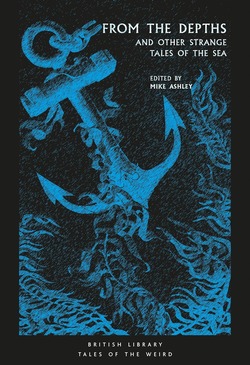From the Depths and Other Strange Tales of the Sea (2018, ed: Mike Ashley) heralded the start of a book series that, seven years later, is showing no signs of slowing down. It’s the British Library’s Tales of the Weird series, soon to be approaching fifty titles. Although they’ve recently expanded into resurrecting old novels, the series is predominantly scouring old magazines looking for tales on themes and anthologising them.
As should be clear from the title, From the Depths is nautical in theme, and gives us a chance to reassess long forgotten writers who wrote stories in this field. My personal opinion is that when stories are selected to meet a brief then we can expect some hits and some misses, and that’s what we find here. Though some of these stories are over a hundred years old, we should cut them some slack: they may have been more impactful in their day.
The editor has selected a good range of stories, with sea monsters and hauntings and more unusual flexes of imagination. The opener, The Ship of Silence (1932) by Albert R. Wetjen holds up well, giving us a tale tinged with Lovecraft. After a potted history of abandoned ships, a la Mary Celeste, we board an empty vessel that is without her crew but shows clear signs of a struggle and an emaciated parrot is the only witness to the unusual events.
Herman Scheffauer’s The Floating Forest (1909), an atmospheric phantasia that leans on Poe, is another highlight. Without monsters or anything truly supernatural, it explores the human drama around a ship, but really follows the life of the ship itself. And what images it delivers with arguably the most evocative prose in the collection. But the collection’s pole star, to my mind, is Morgan Burke’s The Soul-Saver (1926), an uncanny tale of an itinerant skipper and his alleged ability to capture dead men’s souls, which are manifested in the bodies of white mice.
Ashley’s selection seems designed to find stories that feature similar ideas but produce different results. Frank H. Shaw’s Held by the Sargasso and Ward Muir’s Sargasso, both published in 1908, are chalk and cheese in their treatment of the Sargasso Sea. One has seaweed trap a ship with devastating results while the other looks to mutiny for its drama. In similar pairings, sea monsters and ghosts and come with various treatments.
Sadly, Tracked: A Mystery of the Sea (1891) by C.N Barham, about using clairvoyance to locate wrecks, is a bit of a stinker by modern sensibilities. And the collection’s 1920 title story, about a ship searching for wartime’s sunken vessels is so telegraphed that you don’t need to be the previous story’s psychic to see its reveal coming. I also found the deep dive into Willam Hope Hodgson’s oeuvre, The Mystery of the Waterlogged Ship (1911), ultimately disappointing for explaining its central conundrum.
Some of the stores go heavy in their nautical jargon, especially when dealing with pre-steam ships, which may be distracting to some. But many of these writers experienced life at sea and it adds authenticity to their accounts. Three stories by women hold their own in this crew of old salts, although Izola Forrester’s Devereux’s Last Smoke (1907) is arguably too traditional a ghost story to offer something truly weird.
Ashley suggests the volume’s closer, Lady Eleanor Smith’s No Ships Pass (1932) could have been an influence on the TV show Lost. It’s clear to see where he’s coming from in a story about men from different times marooned on a mysterious island that they can’t seem to escape. Regardless, it’s a perfect choice to end the collection as its characters are locked into a tropical Twilight Zone and their predicament continues long after the last page has been turned.
